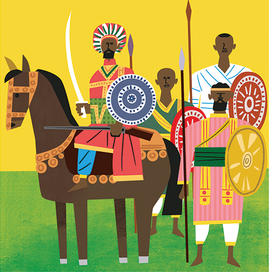Lacy Feigh Understands Ethiopian History and Culture
Lacy Feigh knew that she wanted to research ethiopia after spending two years there as a member of the Peace Corps. As an English teacher, she noticed that some students — predominantly girls — were coming to class late. These girls were working at home and performing domestic tasks such as cooking and cleaning, keeping some of them from attending school regularly and on time.
She was interested in what seemed to her like a “very bonded form of domestic labor” and wanted to learn about the history of this dynamic. Many of the women and girls who were in these roles were from rural and ethnically marginalized communities. Feigh was curious about the connection between this and the domestic labor that enslaved people performed in the 19th and 20th centuries. From her initial interest, Feigh found her way into the field of Ethiopian history and focused on the history of slavery in the formation of the Ethiopian state, the topic of her Ph.D. dissertation, which she completed at the University of Pennsylvania. Now Feigh teaches classes on Ethiopia in Princeton’s history department.
Quick Facts
Title
Lecturer in the Council of the Humanities and History
Time at Princeton
1 year
Recent Class
History of Coffee in Africa and the Middle East
Feigh’s Research: A Sampling

Understanding the Past
Feigh’s work examines the relationship between slavery and the formation of the modern state of Ethiopia. During the imperial period, wars of expansion pushed further outside the boundaries of Ethiopia’s central highlands, closer to the borders of what today are Sudan, South Sudan, and Kenya. People from these peripheral regions were captured and often forced to be travel guides and translators for the army as it pressed further into territory that would eventually become the state of Ethiopia.

Guiding the Way
Part of Feigh’s upcoming book, Abyssinia to Ethiopia: Slavery, Race, and the Transition from Empire to Nation, 1855-1963, focuses on these guides, many of whom were Oromo, or from other ethnic groups in southern Ethiopia. The Oromo are an ethnic group in Ethiopia that has long faced discrimination. These guides were critical to the formation of the modern state of Ethiopia and enabled the expansion and annexation of the state during the imperial period. But Feigh’s research shows how these guides and translators were part of a broader expansion process that depended on their language skills. Feigh’s work focuses on the role of these individuals and how their indigenous knowledge helped create the state of Ethiopia.

Defining Identities
Ethiopia, once called Abyssinia by Europeans and in internal Arabic documents, was the subject of large amounts of debunked race science in the 19th and early 20th centuries, as Ethiopians were often considered by some to be racially between Black and white, though they did not necessarily see themselves this way. This concept, part of a broader theory coined by W.E.B. Du Bois as the “Global Color Line,” promoted race, ethnicity, and color as important features of how countries in the Global South were viewed by their northern counterparts. In the future, Feigh hopes to study coffee production in Ethiopia and the Nile Valley.












No responses yet